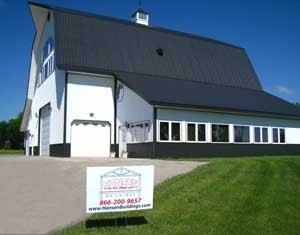Most people building their own post frame post frame home (barndominium or shouse included) need some amount of post frame home construction financing. (shouse=shop+house)
Some important things to keep in mind with construction loans:
Obtaining one takes more time and financial investment than a conventional loan (loan on or against an existing building).
Lenders require more documentation – building plans, budgets, time lines, etc.
“Single Close” loans finance land and post frame home and serve as long-term financing.
“Two Step” loans finance land purchase and construction. New post frame home owners must refinance with a conventional loan upon completion.
Plan on needing at least a 20% down payment. In some cases, if property is free and clear, some or all of land value can be applied toward down payment.
Your lender’s equity will be based upon whatever is least – cost or finished appraised value. Be wary – some items or inclusions have a greater cost than their finished appraised value.
Typical payments are interest upon portion of funds used during construction.
Borrower/builder will take draws as needed to cover materials and labor completed. In an event a general contractor is hired, do not give him or her direct access to funds without you having to approve.
Borrower and builder must be fully approved by lender. This is one of the few cases where I recommend using a general contractor – but only if your lender will not allow you to self-build.
Do NOT apply for your loan telling the potential lender it is a barndominium, pole barn/building or post frame home, etc. Your post frame home should be listed as a “wood framed with a concrete foundation”. Period.

While it sounds ideal to build a post frame home for your specific wants and needs, processes of applying for and closing a construction loan will require a much greater commitment of time and financial resources compared to financing an existing home with a traditional Conventional Mortgage. This is because those banks funding construction loans are investing a considerable sum into an intangible asset, one not yet existing. As such, their requirements for documentation and a greater down payment from buyer are greater than if they were financing an already existing home.
There are effectively two types of construction loans, and while they may go by different names by banks offering them.
A single close construction loan is a single loan financing property acquisition and post frame home construction, it serves as long term financing as well. Since this bank is taking a leap of faith the home will be built “as advertised” with plans and specifications they’ve been provided, they’re still taking a risk in home buyer and builder. If something goes wrong during construction, they could end up being lien holder on a partially constructed post frame home. Since banks are NOT in the business of building homes, they will mitigate this risk charging higher interest rates on construction loans. Greatest risk to a bank closing a construction loan is having either builder or buyer default during construction and higher rates allow them to spread this risk.
A Two Step loan differs as home buyer will close on one loan solely used to finance land purchase and dwelling construction. Once completed, post frame homeowner refinances construction loan with a permanent conventional loan of their choosing.
Both single close and two step loan have their distinct pros and cons and each individual home buyer/builder needs to evaluate those to determine which is best. While a single close loan only requires a borrower to sign one set of loan documents and they have one loan covering both construction and long term home financing, rates at closing are anywhere from .25 to .5% higher than a traditional conventional loan may be. Again, this is due to construction lender’s added risk. Two step loans offer client an ability to choose (after completion) a permanent loan of their liking. Typically this will be at a lower rate than a conventional loan, but two loan closings result in two sets of closing costs, two signings, etc.
Variables a post frame homeowner should consider include length of time they plan to keep the home, current interest rate environment (are rates rising or falling?) and their own risk tolerance knowing rates can and probably will either go up or down while the home is being built.






